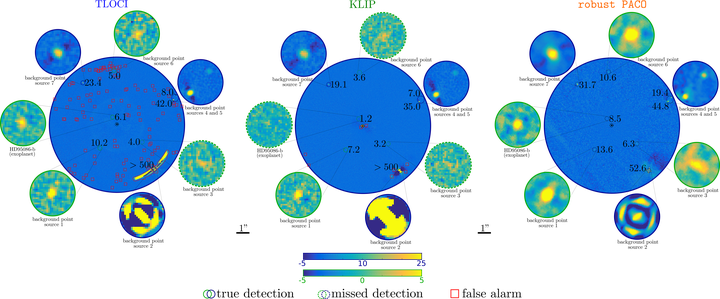Robustness to bad frames in angular differential imaging: a local weighting approach
Astronomy & Astrophysics, vol. 634, A2
 Example of a detection map obtained with robust-PACO comparatively to two state-of-the-art methods on a VLT/SPHERE dataset.
Example of a detection map obtained with robust-PACO comparatively to two state-of-the-art methods on a VLT/SPHERE dataset.
Abstract
Context. The detection of exoplanets by direct imaging is very challenging. It requires an extreme adaptive-optics (AO) system and a coronagraph as well as suitable observing strategies. In angular differential imaging, the signal-to-noise ratio is improved by combining several observations.
Aims. Due to the evolution of the observation conditions and of the AO correction, the quality of the observations may vary significantly during the observing sequence. It is common practice to reject images of comparatively poor quality. We aim to decipher when this selection should be performed and what its impact on detection performance is.
Methods. Rather than discarding a full image, we study the local fluctuations of the signal at each frame and derive weighting maps for each frame. These fluctuations are modeled locally directly from the data through the spatio-temporal covariance of small image patches. The weights derived from the temporal variances can be used to improve the robustness of the detection step and reduce estimation errors of both the astrometry and photometry. The impact of bad frames can be analyzed by statistically characterizing the detection and estimation performance.
Results. When used together with a modeling of the spatial covariances (PACO algorithm), these weights improve the robustness of the detection method.
Conclusions. The spatio-temporal modeling of the background fluctuations provides a way to exploit all acquired frames. In the case of bad frames, areas with larger fluctuations are discarded by a weighting strategy and do not corrupt the detection map or the astrometric and photometric estimations. Other areas of better quality are preserved and are included to detect and characterize sources.